Abstract
Among 12 cases of chronic T lymphoproliferative disorders we observed, six patients showed an expansion of mononuclear cells with azurophilic granules usually referred to as large granular lymphocytes or LGL. Cells obtained from five patients with these abnormal LGL proliferations were studied with several surface markers including their reactivity with the HNK-1 monoclonal antibody reported to be specific for LGL. Cells in four out of five cases were HNK-1 positive. Whereas normal LGL have been reported to be unreactive with several T cell markers, three cases showed the co-existence of HNK-1 and surface markers expressed by T cells. Two cases were characterized by the proliferation of OKT8 cells. Cells from one patient were HNK-1 positive but did not express T or monocytic antigens. These cells were apparently not completely mature since alpha-naphthyl acetate acid esterase activity was negative. Cells from the remaining case were HNK-1 negative and positive for T and monocytic antigens. An increase of OKT-10 cells was observed in only one patient. Our data indicate that proliferations of LGL represent a remarkable proportion of the rare cases of sheep erythrocyte rosetting chronic lymphocytic leukaemias or lymphomas. Besides the morphology of LGL, the rosetting ability and the negativity for peroxidase, cells from these cases showed a vast heterogeneity of other structural and functional markers, possibly reflecting different stages in the maturation of these cells. The HNK-1 monoclonal antibody proved to be an important marker in the identification of these cases.
Full text
PDF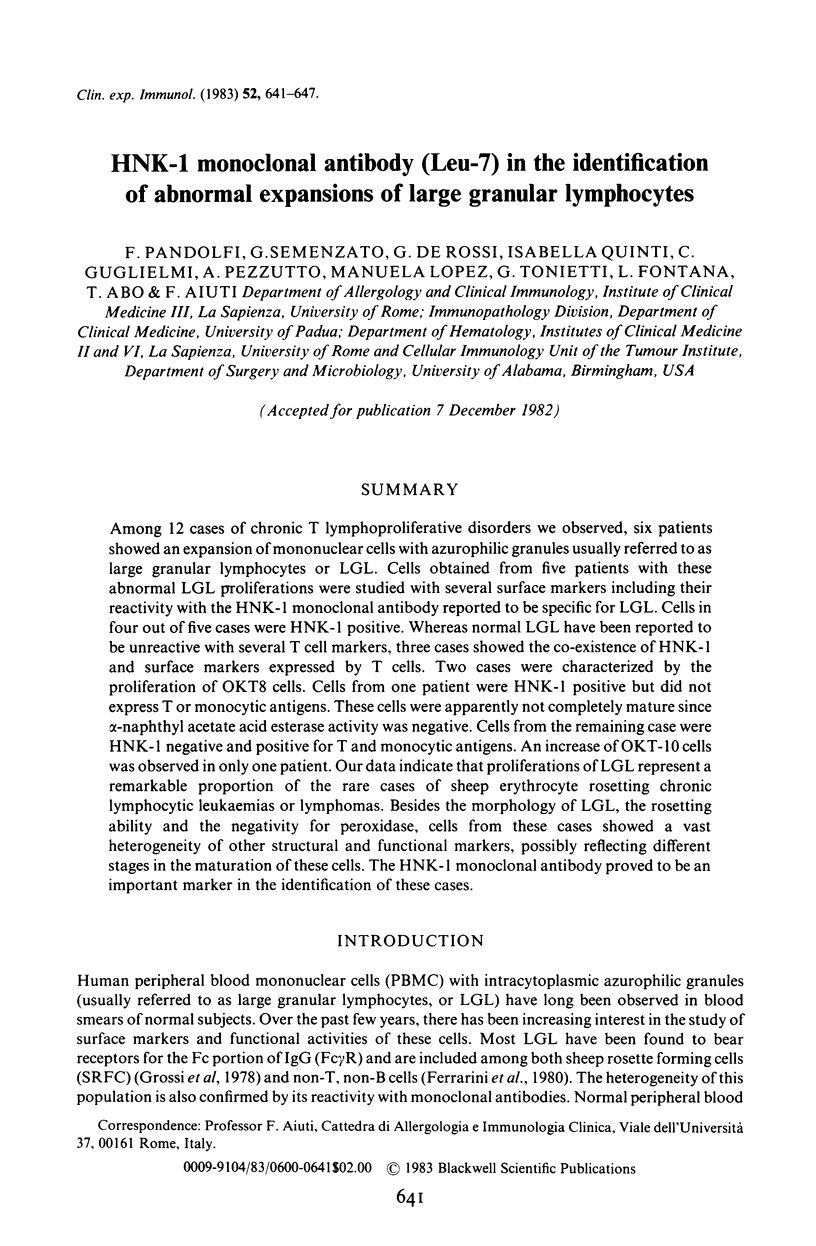
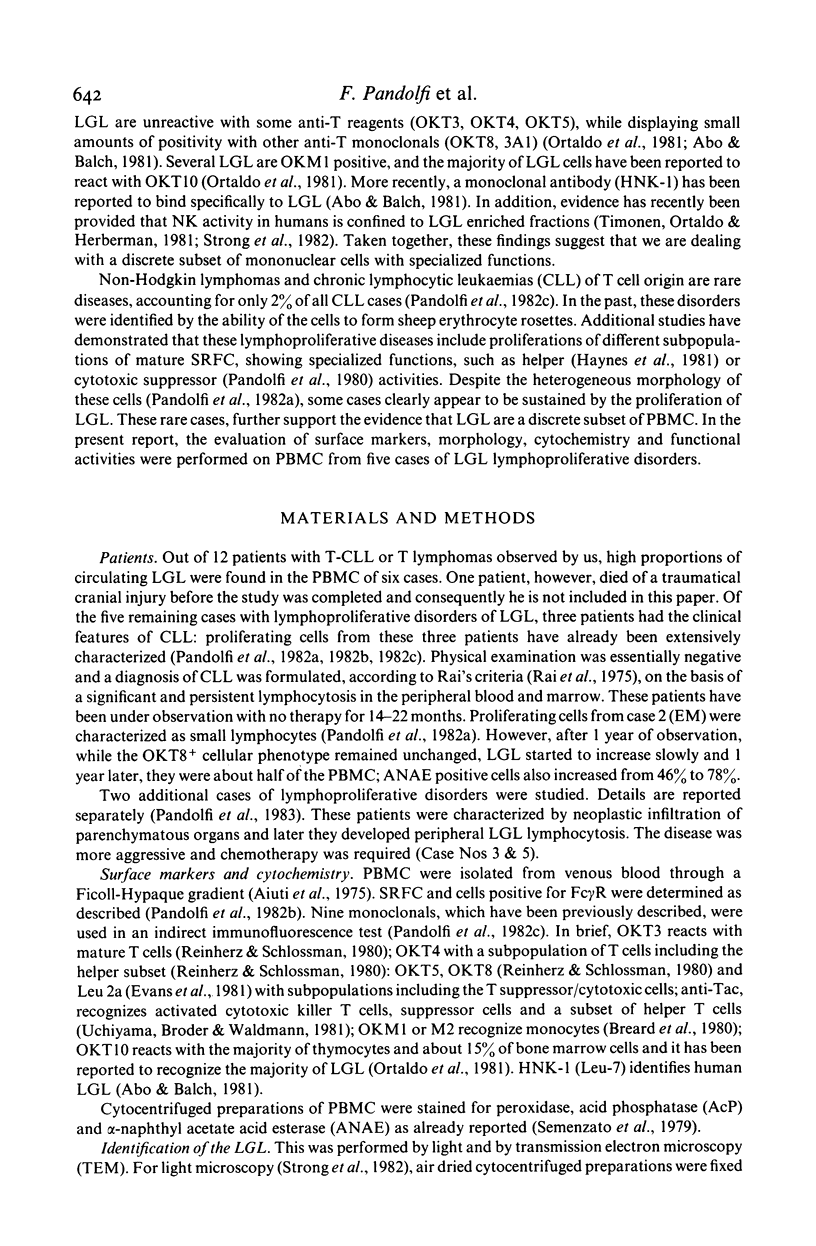
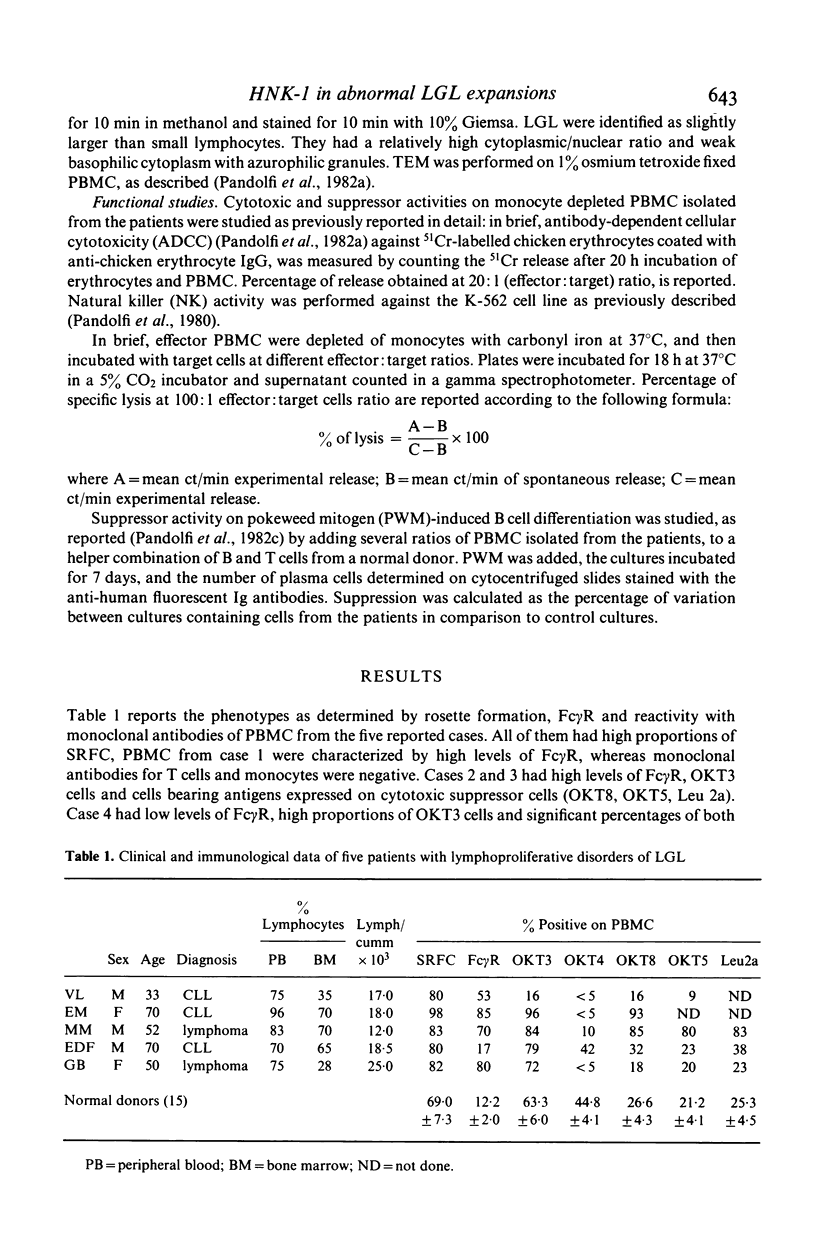

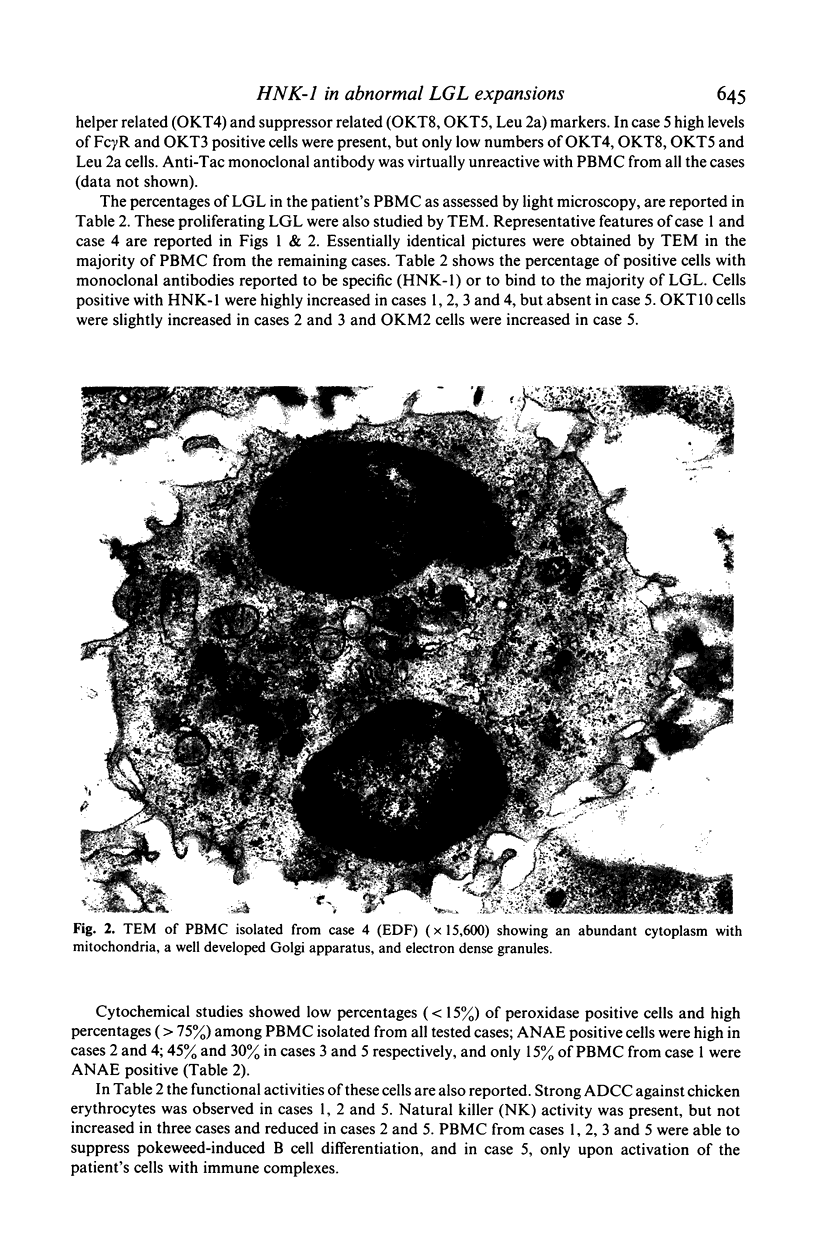
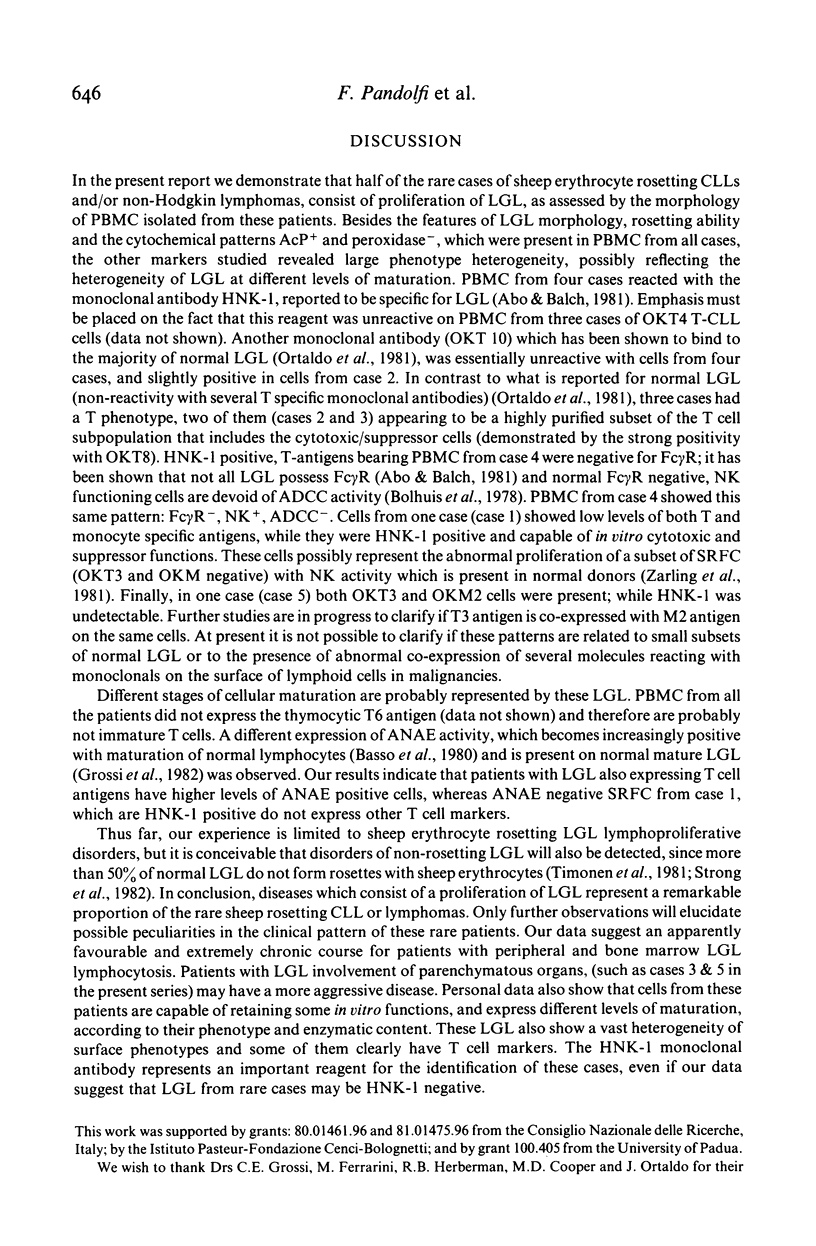
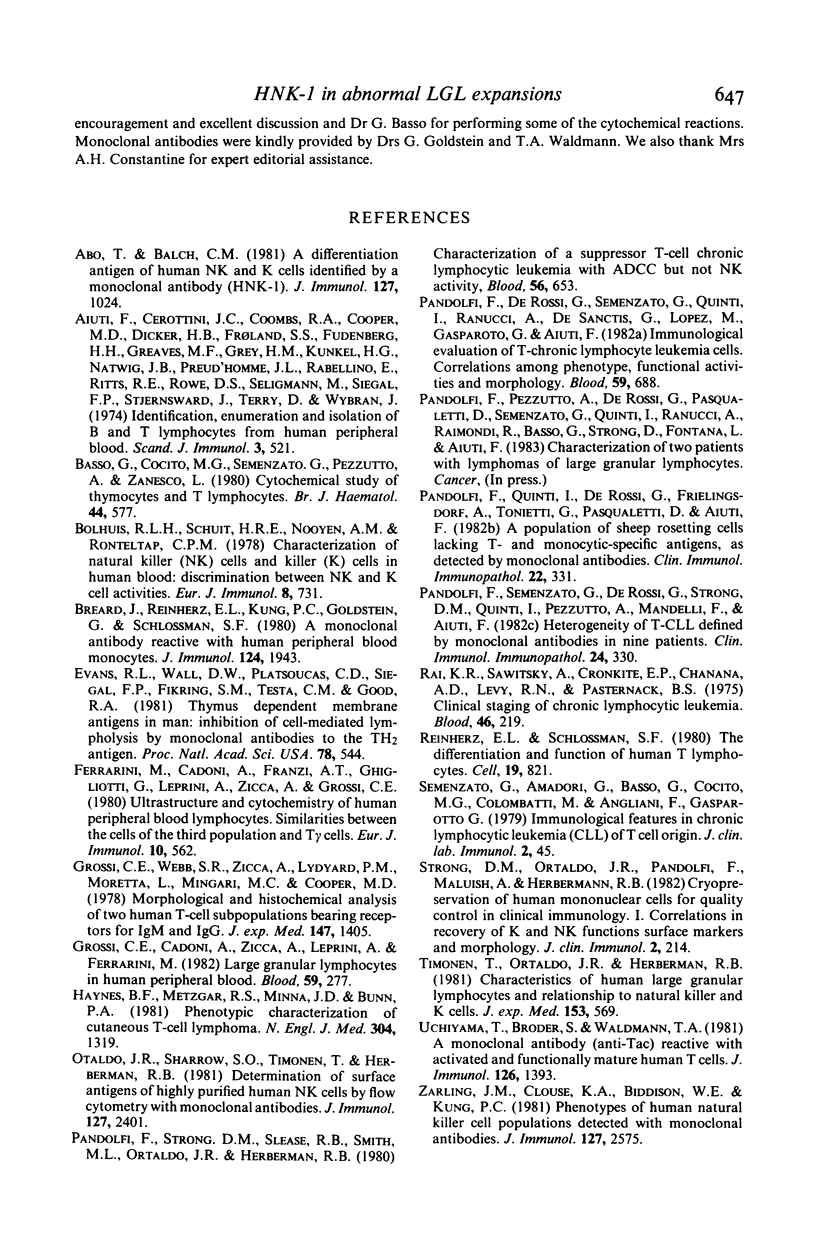
Images in this article
Selected References
These references are in PubMed. This may not be the complete list of references from this article.
- Abo T., Balch C. M. A differentiation antigen of human NK and K cells identified by a monoclonal antibody (HNK-1). J Immunol. 1981 Sep;127(3):1024–1029. [PubMed] [Google Scholar]
- Basso G., Cocito M. G., Semenzato G., Pezzutto A., Zanesco L. Cytochemical study of thymocytes and T lymphocytes. Br J Haematol. 1980 Apr;44(4):577–582. doi: 10.1111/j.1365-2141.1980.tb08712.x. [DOI] [PubMed] [Google Scholar]
- Bolhuis R. L., Schuit H. R., Nooyen A. M., Ronteltap C. P. Characterization of natural killer (NK) cells and killer (K) cells in human blood: discrimination between NK and K cell activities. Eur J Immunol. 1978 Oct;8(10):731–740. doi: 10.1002/eji.1830081012. [DOI] [PubMed] [Google Scholar]
- Breard J., Reinherz E. L., Kung P. C., Goldstein G., Schlossman S. F. A monoclonal antibody reactive with human peripheral blood monocytes. J Immunol. 1980 Apr;124(4):1943–1948. [PubMed] [Google Scholar]
- Evans R. L., Wall D. W., Platsoucas C. D., Siegal F. P., Fikrig S. M., Testa C. M., Good R. A. Thymus-dependent membrane antigens in man: inhibition of cell-mediated lympholysis by monoclonal antibodies to TH2 antigen. Proc Natl Acad Sci U S A. 1981 Jan;78(1):544–548. doi: 10.1073/pnas.78.1.544. [DOI] [PMC free article] [PubMed] [Google Scholar]
- Ferrarini M., Cadoni A., Franzi A. T., Ghigliotti C., Leprini A., Zicca A., Grossi C. E. Ultrastructure and cytochemistry of human peripheral blood lymphocytes. Similarities between the cells of the third population and TG lymphocytes. Eur J Immunol. 1980 Jul;10(7):562–570. doi: 10.1002/eji.1830100714. [DOI] [PubMed] [Google Scholar]
- Grossi C. E., Cadoni A., Zicca A., Leprini A., Ferrarini M. Large granular lymphocytes in human peripheral blood: ultrastructural and cytochemical characterization of the granules. Blood. 1982 Feb;59(2):277–283. [PubMed] [Google Scholar]
- Grossi C. E., Webb S. R., Zicca A., Lydyard P. M., Moretta L., Mingari M. C., Cooper M. D. Morphological and histochemical analyses of two human T-cell subpopulations bearing receptors for IgM or IgG. J Exp Med. 1978 May 1;147(5):1405–1417. doi: 10.1084/jem.147.5.1405. [DOI] [PMC free article] [PubMed] [Google Scholar]
- Haynes B. F., Metzgar R. S., Minna J. D., Bunn P. A. Phenotypic characterization of cutaneous T-cell lymphoma. Use of monoclonal antibodies to compare with other malignant T cells. N Engl J Med. 1981 May 28;304(22):1319–1323. doi: 10.1056/NEJM198105283042202. [DOI] [PubMed] [Google Scholar]
- Identification, enumeration, and isolation of B and T lymphocytes from human peripheral blood. Report of a WHO-IARC-sponsored workshop on human B and T cells, London, 15-17 July 1974. Scand J Immunol. 1974;3(5):521–532. [PubMed] [Google Scholar]
- Ortaldo J. R., Sharrow S. O., Timonen T., Herberman R. B. Determination of surface antigens on highly purified human NK cells by flow cytometry with monoclonal antibodies. J Immunol. 1981 Dec;127(6):2401–2409. [PubMed] [Google Scholar]
- Pandolfi F., Quinti I., De Rossi G., Frielingsdorf A., Tonietti G., Pasqualetti D., Aiuti F. A population of sheep rosetting cells lacking T- and monocytic-specific antigens, as detected by monoclonal antibodies. Clin Immunol Immunopathol. 1982 Mar;22(3):331–339. doi: 10.1016/0090-1229(82)90050-2. [DOI] [PubMed] [Google Scholar]
- Pandolfi F., Semenzato G., De Rossi G., Strong D. M., Quinti I., Pezzutto A., Mandelli F., Aiuti F. Heterogeneity of T-CLL defined by monoclonal antibodies in nine patients. Clin Immunol Immunopathol. 1982 Sep;24(3):330–341. doi: 10.1016/0090-1229(82)90004-6. [DOI] [PubMed] [Google Scholar]
- Pandolfi F., Strong D. M., Slease R. B., Smith M. L., Ortaldo J. R., Herberman R. B. Characterization of a suppressor T-cell chronic lymphocytic leukemia with ADCC but not NK activity. Blood. 1980 Oct;56(4):653–660. [PubMed] [Google Scholar]
- Rai K. R., Sawitsky A., Cronkite E. P., Chanana A. D., Levy R. N., Pasternack B. S. Clinical staging of chronic lymphocytic leukemia. Blood. 1975 Aug;46(2):219–234. [PubMed] [Google Scholar]
- Reinherz E. L., Schlossman S. F. The differentiation and function of human T lymphocytes. Cell. 1980 Apr;19(4):821–827. doi: 10.1016/0092-8674(80)90072-0. [DOI] [PubMed] [Google Scholar]
- Strong D. M., Ortaldo J. R., Pandolfi F., Maluish A., Herberman R. B. Cryopreservation of human mononuclear cells for quality control in clinical immunology. I. Correlations in recovery of K- and NK-cell functions, surface markers, and morphology. J Clin Immunol. 1982 Jul;2(3):214–221. doi: 10.1007/BF00915224. [DOI] [PubMed] [Google Scholar]
- Timonen T., Ortaldo J. R., Herberman R. B. Characteristics of human large granular lymphocytes and relationship to natural killer and K cells. J Exp Med. 1981 Mar 1;153(3):569–582. doi: 10.1084/jem.153.3.569. [DOI] [PMC free article] [PubMed] [Google Scholar]
- Zarling J. M., Clouse K. A., Biddison W. E., Kung P. C. Phenotypes of human natural killer cell populations detected with monoclonal antibodies. J Immunol. 1981 Dec;127(6):2575–2580. [PubMed] [Google Scholar]




